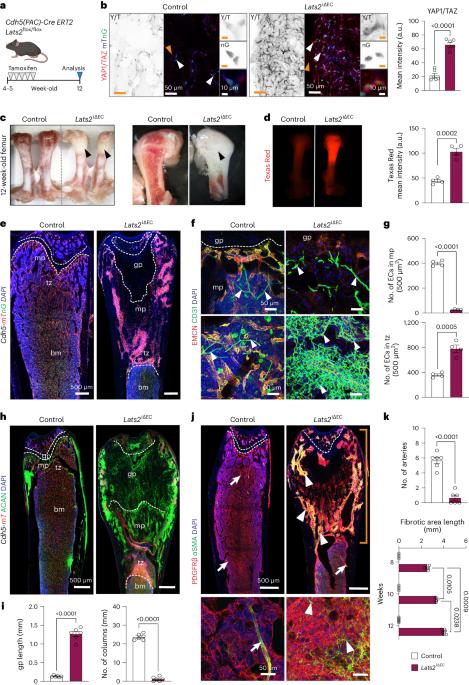Endothelial LATS2 is a suppressor of bone marrow fibrosis
IF 9.4
Q1 CARDIAC & CARDIOVASCULAR SYSTEMS
引用次数: 0
Abstract
Myelofibrosis and osteosclerosis are fibrotic diseases disrupting bone marrow function that occur in various leukemias but also in response to non-malignant alterations in hematopoietic cells. Here we show that endothelial cell–specific inactivation of the Lats2 gene, encoding Hippo kinase large tumor suppressor kinase 2, or overexpression of the downstream effector YAP1 induce myofibroblast formation and lead to extensive fibrosis and osteosclerosis, which impair bone marrow function and cause extramedullary hematopoiesis in the spleen. Mechanistically, loss of LATS2 induces endothelial-to-mesenchymal transition, resulting in increased expression of extracellular matrix and secreted signaling molecules. Changes in endothelial cells involve increased expression of serum response factor target genes, and, strikingly, major aspects of the LATS2 mutant phenotype are rescued by inactivation of the Srf gene. These findings identify the endothelium as a driver of bone marrow fibrosis, which improves understanding of myelofibrotic and osteosclerotic diseases, for which drug therapies are currently lacking. Sivaraj, Majev et al. demonstrate that the inactivation of Lats2 in endothelial cells triggers the upregulation of serum response factor and endothelial-to-mesenchymal transition, leading to myofibroblast formation, bone marrow fibrosis, osteosclerosis, impaired bone marrow function and extramedullary hematopoiesis.

内皮细胞 LATS2 是骨髓纤维化的抑制因子
骨髓纤维化和骨硬化是一种破坏骨髓功能的纤维化疾病,可发生在各种白血病中,也可发生在造血细胞的非恶性改变中。在这里,我们发现,内皮细胞特异性失活编码希波激酶大型肿瘤抑制激酶 2 的 Lats2 基因或过表达下游效应物 YAP1 会诱导肌成纤维细胞的形成,导致广泛的纤维化和骨硬化,从而损害骨髓功能,引起脾脏髓外造血。从机理上讲,LATS2 的缺失会诱导内皮细胞向间质转化,导致细胞外基质和分泌信号分子的表达增加。内皮细胞的变化涉及血清反应因子靶基因表达的增加,而且令人震惊的是,LATS2突变体表型的主要方面可通过Srf基因的失活得到挽救。这些发现确定了内皮细胞是骨髓纤维化的驱动因素,从而加深了人们对骨髓纤维化和骨硬化性疾病的了解,而这些疾病目前还缺乏药物疗法。Sivaraj、Majev 等人证明,内皮细胞中 Lats2 失活会引发血清反应因子上调和内皮细胞向间质转化,从而导致肌成纤维细胞形成、骨髓纤维化、骨硬化、骨髓功能受损和髓外造血。
本文章由计算机程序翻译,如有差异,请以英文原文为准。
求助全文
约1分钟内获得全文
求助全文

 求助内容:
求助内容: 应助结果提醒方式:
应助结果提醒方式:


